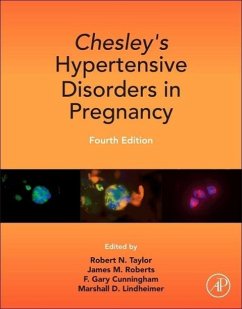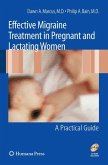Chesley's Hypertensive Disorders in Pregnancy continues its tradition as one of the beacons to guide the field of preeclampsia research, recognized for its uniqueness and utility. Hypertensive disorders remain one the major causes of maternal and fetal morbidity and death. It is also a leading cause of preterm birth now known to be a risk factor in remote cardiovascular disease. Despite this the hypertensive disorders remain marginally studied and management is often controversial. The fourth edition of Chesley's Hypertensive Disorders in Pregnancy focuses on prediction, prevention, and management for clinicians, and is an essential reference text for clinical and basic investigators alike. Differing from other texts devoted to preeclampsia, it covers the whole gamut of high blood pressure, and not just preeclampsia.
Features new chapters focusing on recent discoveries in areas such as fetal programming, genomics/proteomics, and angiogenesis Includes extensive updates to chapters on epidemiology, etiological considerations, pathophysiology, prediction, prevention, and management Discusses the emerging roles of metabolic syndrome and obesity and the increasing incidence of preeclampsia Each section overseen by one of the editors; each chapter co-authored by one of the editors, ensuring coherence throughout book
Hinweis: Dieser Artikel kann nur an eine deutsche Lieferadresse ausgeliefert werden.
Features new chapters focusing on recent discoveries in areas such as fetal programming, genomics/proteomics, and angiogenesis Includes extensive updates to chapters on epidemiology, etiological considerations, pathophysiology, prediction, prevention, and management Discusses the emerging roles of metabolic syndrome and obesity and the increasing incidence of preeclampsia Each section overseen by one of the editors; each chapter co-authored by one of the editors, ensuring coherence throughout book
Hinweis: Dieser Artikel kann nur an eine deutsche Lieferadresse ausgeliefert werden.
Praise for the Fourth Edition:
"This book constitutes an indispensable update on preeclampsia, one of the most important and intriguing diseases of pregnancy. It covers the genetic, mechanistic, immunological and medical aspects of hypertension in pregnancy in a very comprehensive way. It is written clearly by world specialists in the subject, making it accessible to students, scientists and physicians as well." --Daniel Vaiman, PhD, HDR, Head Team "Genetics, Epigenetics, Physiopathology of Reproduction,"Co-Head, Department "Development, Reproduction, Cancer," Cochin Institute, INSERM, Cochin Hospital, Paris, France
"Once again the editors of Chesley's Hypertensive Disorders of Pregnancy have put together an outstanding team of contributors, combining investigators and clinicians, with expertise in preeclampsia to help elucidate our current understanding of this complex disorder. These contributors have put together an exemplary text that highlights recent basic science and clinical research as well as their implications for clinical care and future investigation. I suspect Dr. Chesley would be proud to see that his name continues to lead such an impressive tome." --Ira M. Bernstein, MD, John van Sicklen Maeck Professor and Chair, Department of Obstetrics, Gynecology and Reproductive Science, College of Medicine, University of Vermont, Burlington, VT, USA
"This 4th edition of Chesley's classic textbook provides a superb analysis of the multiple topics that relate to hypertension in pregnancy, especially of preeclampsia, its most delicate condition. These range from the epidemiology to the molecular aspects, all analyzed from the background of normal pregnancy. Each chapter has been written by leaders in their respective areas, who discuss pioneering studies to still latent questions, simple interventions to sophisticated future tools, preconceptional management to the risks that mothers and offspring may face in later life. Clinical observations are conciliated with animal models and opposing hypotheses are united into continua (e.g., from an "underfilled" state in early pregnancy to an "overfill" in late pregnancy, from salt as a pressor element to an activator of the immune system). Putting into perspective the advancements made in the 47 years that separate this from the 1st edition illuminates the multiple achievements as well as the bridges that remain to be crossed. This text is a great way to honor the memory of Dr. Leon Chesley, the leader of this still open path, and should be obligatory reading for obstetricians, nephrologists, cardiologists and endocrinologists alike." --Gloria Valdes, MD, Professor, School of Medicine, Pontifi cia Universidad Católica, Santiago, Chile
Review of the Second Edition: "Preeclampsia remains a lethal enigma of pregnancy. Encompassing more than just hypertension, it can include abnormalities of platelet behavior and clotting mechanisms and of endothelial, hepatic, and renal function. The first edition of Leon Chesley's Hypertensive Disorders in Pregnancy (1978) was a scholarly monograph, written by a scientist with a passionate interest in the condition. Since then, the number of maternal deaths from preeclampsia and eclampsia per million pregnancies has been halved in developed countries. Nevertheless, preeclampsia, together with eclampsia, remains one of the two most frequently cited causes of maternal death in the West. The second edition is a multiauthored book. The three editors are researchers who have made a particular effort to achieve a degree of homogeneity in the presentation. The contents are divided into six main sections, each overseen by one of the three editors. Each chapter is also coauthored by one of the editors, which has resulted in coherence in the writing among chapters. Most of the chapters begin with a paragraph about how the topic was considered by Chesley that emphasizes the forward-looking and comprehensive nature of his interest... This book is an authoritative compilation of knowledge in the area, with many references from the second half of the 1990s. It should certainly be in the library of every academic department." --The New England Journal of Medicine
"This book constitutes an indispensable update on preeclampsia, one of the most important and intriguing diseases of pregnancy. It covers the genetic, mechanistic, immunological and medical aspects of hypertension in pregnancy in a very comprehensive way. It is written clearly by world specialists in the subject, making it accessible to students, scientists and physicians as well." --Daniel Vaiman, PhD, HDR, Head Team "Genetics, Epigenetics, Physiopathology of Reproduction,"Co-Head, Department "Development, Reproduction, Cancer," Cochin Institute, INSERM, Cochin Hospital, Paris, France
"Once again the editors of Chesley's Hypertensive Disorders of Pregnancy have put together an outstanding team of contributors, combining investigators and clinicians, with expertise in preeclampsia to help elucidate our current understanding of this complex disorder. These contributors have put together an exemplary text that highlights recent basic science and clinical research as well as their implications for clinical care and future investigation. I suspect Dr. Chesley would be proud to see that his name continues to lead such an impressive tome." --Ira M. Bernstein, MD, John van Sicklen Maeck Professor and Chair, Department of Obstetrics, Gynecology and Reproductive Science, College of Medicine, University of Vermont, Burlington, VT, USA
"This 4th edition of Chesley's classic textbook provides a superb analysis of the multiple topics that relate to hypertension in pregnancy, especially of preeclampsia, its most delicate condition. These range from the epidemiology to the molecular aspects, all analyzed from the background of normal pregnancy. Each chapter has been written by leaders in their respective areas, who discuss pioneering studies to still latent questions, simple interventions to sophisticated future tools, preconceptional management to the risks that mothers and offspring may face in later life. Clinical observations are conciliated with animal models and opposing hypotheses are united into continua (e.g., from an "underfilled" state in early pregnancy to an "overfill" in late pregnancy, from salt as a pressor element to an activator of the immune system). Putting into perspective the advancements made in the 47 years that separate this from the 1st edition illuminates the multiple achievements as well as the bridges that remain to be crossed. This text is a great way to honor the memory of Dr. Leon Chesley, the leader of this still open path, and should be obligatory reading for obstetricians, nephrologists, cardiologists and endocrinologists alike." --Gloria Valdes, MD, Professor, School of Medicine, Pontifi cia Universidad Católica, Santiago, Chile
Review of the Second Edition: "Preeclampsia remains a lethal enigma of pregnancy. Encompassing more than just hypertension, it can include abnormalities of platelet behavior and clotting mechanisms and of endothelial, hepatic, and renal function. The first edition of Leon Chesley's Hypertensive Disorders in Pregnancy (1978) was a scholarly monograph, written by a scientist with a passionate interest in the condition. Since then, the number of maternal deaths from preeclampsia and eclampsia per million pregnancies has been halved in developed countries. Nevertheless, preeclampsia, together with eclampsia, remains one of the two most frequently cited causes of maternal death in the West. The second edition is a multiauthored book. The three editors are researchers who have made a particular effort to achieve a degree of homogeneity in the presentation. The contents are divided into six main sections, each overseen by one of the three editors. Each chapter is also coauthored by one of the editors, which has resulted in coherence in the writing among chapters. Most of the chapters begin with a paragraph about how the topic was considered by Chesley that emphasizes the forward-looking and comprehensive nature of his interest... This book is an authoritative compilation of knowledge in the area, with many references from the second half of the 1990s. It should certainly be in the library of every academic department." --The New England Journal of Medicine








